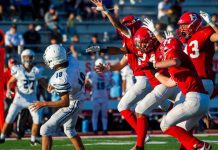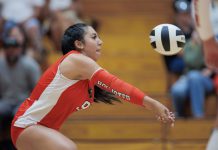Editor’s note: This is the first article in a three-part series
focusing on head and neck injuries in football, and how prepared
local sports programs are in preventing and responding to such
injuries.
Editor’s note: This is the first article in a three-part series focusing on head and neck injuries in football, and how prepared local sports programs are in preventing and responding to such injuries.
Maureen Miner has a story she often tells when the topic of concussions comes up.
A friend of Miner’s, who is part of the National Institute of Health and a neurophysiologist at UCLA, was standing on the sidelines during a Bruins football game when a player suffered a concussion. A trainer came over and asked Miner’s colleague if he could do a PET scan (Positron emission tomography) of the player’s brain to measure the impact of the injury. Obliging, a radiologist then told Miner’s colleague to look at the results, causing the gentleman to reply, ” ‘No, no, no, that’s my coma patient. I want to see the guy you just did,’ ” Miner said.
The image was actually from the injured player.
“What that tells us is that the early signs, or the early situations of a concussion can mimic what a comatose patient looks like,” said Miner, a medical doctor and Diplomate of the American Board of Physical Medicine & Rehabilitation and the American Board of Pain Medicine. “It just goes to show you that concussions are more problematic than we all thought. What was lacking was medical documentation.”
One of the trickier injuries to diagnose and treat, concussions are receiving more attention than ever before. What seems to be a rash of head injuries amongst football players of all levels has helped create the increased interest.
Trent Green, a quarterback for the National Football League’s Miami Dolphins, was recently ruled unable to play for the rest of the season after suffering his second concussion in 13 months. It may be a career-ending injury. A month ago, Palma High quarterback and Gilroy resident Connor Farotte suffered a seizure on the sidelines of a game against North Salinas after complaining of headaches. He spent the next two days in the intensive care unit of Salinas Valley Memorial Hospital after doctors discovered bleeding on the brain. Farotte is expected to make a full recovery within a year.
While football isn’t the only sport that can be associated with concussions, it’s certainly the game where they most commonly occur.
“I have more ankle sprains and knee injuries in basketball, but I don’t see concussions in hardly any other sport other than football,” said Jennifer Spinetti, a Certified Athletic Trainer for Gilroy High School.
“Football, of course, is the worst offender because it is a high impact sport,” said Dr. Emeka Nchekwube, a neurosurgeon based out of Morgan Hill who has operated on athletes of all levels. “As far as the nervous system occurs, most of the injuries come from concussion … and neck injuries.”
When a football player gets his bell rung today though, especially a youth football player, it isn’t a matter of shaking off the cobwebs. With liability, lawsuits and a larger amount of knowledgeable medical professionals patrolling sidelines, the alarm is being sounded. Still, games being played in Pop Warner on up to preps often don’t have someone who can properly diagnose head trauma.
“Oh yes, it’s definitely more difficult to detect because the kids will either not know where they are (in terms of severity) or the coaches keep putting them back in (the game),” Miner said. “It’s just a mentality (in football) to keep on going than in most sports. If a kid gets hit with a baseball bat and everyone else is standing and he’s falling over, it’s going to be a much more obvious situation than in football.”
According to MayoClinic.com, the most obvious signs of a concussion consist of headaches, dizziness, ringing in the ears, nausea, vomiting and slurred speech. However, symptoms of a concussion can also appear hours or days after a blow to the head and include mood and cognitive disturbances, sensitivity to light and noise and sleep disturbances.
An even greater risk for athletes under the age of 18 comes with a second concussion, which can lead to permanent brain damage or even death according to a Sept. 15 article in the New York Times.
“Almost solely among teenagers, sustaining another blow to the head – even a seemingly benign one – before a first has healed can set off a devastating chain of metabolic events: Cerebral blood flow increases, arteries swell past capacity, and pressure builds inside the brain, often leading to coma and death. Helmets can do only so much to keep youngsters’ brains from sloshing inside their skulls, like the yolk inside an egg.”
The Times article cited a national survey that indicates 15 percent of all high school football players suffer a concussion of some degree each season.
Catastrophic events such as deaths from second-impact syndrome have led to legislation in some states, but instituting mandatory rules and regulations has been a slow-moving process.
Dr. Nchekwube says the most important thing people involved in sports can do is become more informed.
“I think education at the college and high school levels (is most important),” he said. “Educating the athletes about the types of injuries they face and how to avoid them, in terms of training and posturing.”
Miner said the pressure on college and professional athletes to get back in a game after a concussion, whether internal or external, is another aspect that needs to be monitored.
“There is this difficult balance to maintain, or there is a dichotomy of thinking because (colleges) want to protect the kids, but want the money and the publicity (with winning),” she said.
The NFL has a hotline players can call to report concussions of their own or if they suspect another player isn’t reporting a problem. Nationally, the high school and college levels have yet to install a similar program.









